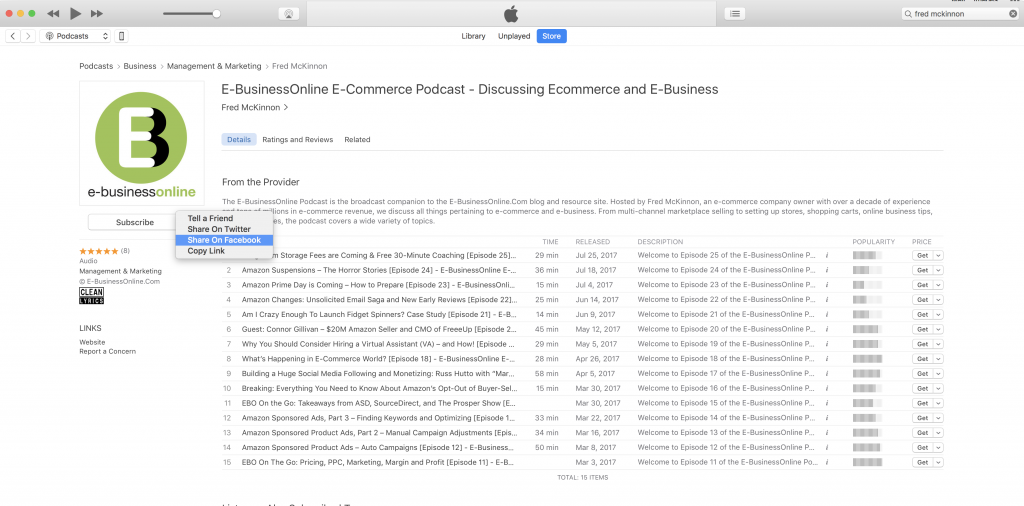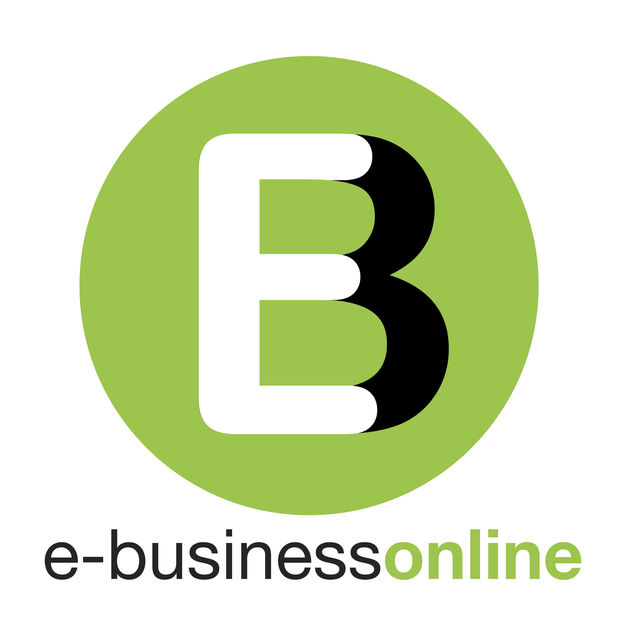
E-BusinessOnline E-Commerce Podcast - Discussing Ecommerce and E-Business
Fred McKinnon
The E-BusinessOnline Podcast is the broadcast companion to the E-BusinessOnline.Com blog and resource site. Hosted by Fred McKinnon, an e-commerce company owner with over a decade of experience and tens of millions in e-commerce revenue, we discuss all things pertaining to e-commerce and e-business. From multi-channel marketplace selling to setting up stores, shopping carts, online business tips, tricks and stories, the podcast covers a wide variety of topics.
- 13 minutes5 Reasons Why Walmart WFS Is Better Than Amazon FBAReading Time: 4 minutes
If you’re in the e-commerce business, you already know the importance of finding the right fulfillment service. Today, Walmart Fulfillment Services (WFS) is showing up as a serious competitor to Amazon FBA (Fulfillment by Amazon). With over 20 years of experience selling on both platforms, I can confidently say Walmart WFS is not just an alternative — in many ways, it’s better than FBA.
In this post, I’ll break down five solid reasons why Walmart WFS is better than Amazon FBA. Whether you’re new to selling or a veteran looking to cut costs and streamline operations, you’ll want to pay attention.
Understanding the Basics: Walmart WFS vs. Amazon FBA
Before jumping straight into the reasons, here’s a quick comparison of how both services work. In both Amazon FBA and Walmart WFS, sellers send their inventory to the respective fulfillment center. From there, the platforms handle storage, packing, and shipping.
For Amazon FBA, products have the appeal of being Prime-eligible, which can boost conversions. Similarly, Walmart WFS makes products eligible for Walmart’s 2-day shipping. This high-speed service is perfect for the millions of Walmart customers who are used to fast delivery.
Now, let’s dive into why Walmart WFS has an edge over Amazon FBA.
1. Lower Fulfillment Fees (Most of the Time)
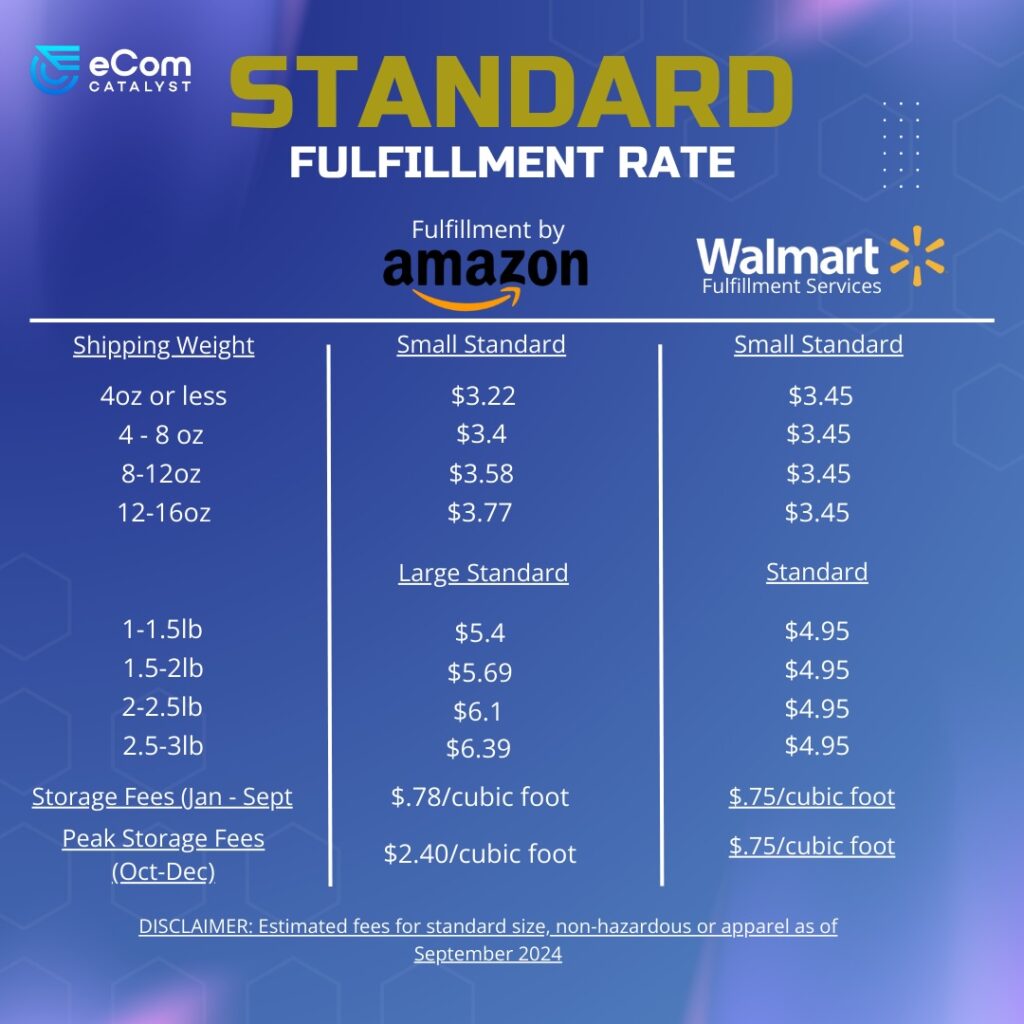
The first clear advantage of Walmart WFS is lower overall fulfillment fees. Amazon may be competitive on tiny, lightweight items like phone cases, but once you get into products that weigh more than a few ounces, Walmart takes the win.
Here’s a quick comparison:
- For a product that weighs 12-16 oz, Amazon charges $4.75 per order, whereas Walmart only charges $3.45.
- For a 1-1.5 lb product, Amazon’s rate is $5.69, yet Walmart stays at $4.95.
That may not seem like much, but over hundreds or even thousands of orders, those savings stack up fast. When every penny counts, Walmart’s cheaper rates simply make sense.
2. Storage Fees: Consistently Cheaper, Especially During Peak Season
Amazon and Walmart charge similar base storage fees throughout the year, with Amazon at around 78 cents and Walmart slightly lower at 75 cents per cubic foot. But here’s where Walmart makes a huge difference — peak season pricing.
Amazon’s storage fees explode during the October-December holiday season, jumping from 78 cents to a whopping $2.40 per cubic foot. Walmart, on the other hand, doesn’t jack up its prices. If you get your inventory into Walmart’s warehouses by September 30th, you’ll still pay just 75 cents per cubic foot, even during the holiday rush.
No holiday storage price hikes. For sellers focused on maximizing profit, this is a game-changer.
3. No Inbound Placement Fees
Amazon makes it complicated and costly to send inventory into their warehouses. You either have to pay for expensive inbound placement fees, or strategically ship products to multiple warehouse locations. This adds money, headache, and time.
Walmart WFS couldn’t be any simpler. Just send your inventory to one location, and they take care of the rest. No inbound placement fees. Nothing complicated about where and how to ship products. At Ecom Catalyst, we’ve sent products from our Georgia office to Walmart’s fulfillment center in Florida using FedEx ground, and the whole process was smooth and fast.
This factor alone makes Walmart WFS much easier and cheaper for sellers who don’t want the hassle that Amazon routinely creates.
4. Multi-Channel Fulfillment Options Now Available
Amazon’s Multi-Channel Fulfillment (MCF) has been a huge selling point for years. You could sell on other platforms like Shopify and still have Amazon fulfill orders for you. Walmart was missing this feature—until now.
Walmart WFS now offers multi-channel fulfillment, meaning you can have your Walmart inventory fulfill orders for sales not just from Walmart, but also Shopify, Etsy, eBay, and more. This recent update from Walmart completely erases Amazon’s advantage in this area.
The ability to streamline fulfillment across multiple sales platforms makes Walmart WFS the better choice for sellers looking to simplify logistics. Plus, using Walmart instead of Amazon aligns you with a major U.S. retailer growing in marketplace share.
5. Higher Conversion Rates
Shoppers trust fulfillment from their favorite marketplace. It’s the difference between a listing that says “ships by Amazon” or “ships by Walmart” versus one that says “ships by XYZ Seller.”
Studies show that when your product is fulfilled by Amazon or Walmart, customers are far more likely to complete the purchase. People trust the fast delivery, reliability, and customer service these platforms have built their names on. According to internal reports, Walmart WFS can boost your conversion rate by over 30%.
That increased trust translates directly into more sales. Especially with Walmart WFS picking up speed in the market, now’s the best time to take advantage of their growing fulfillment service.
Conclusion
Walmart WFS is emerging as the better fulfillment option for many sellers. With lower fulfillment fees, especially for larger items, stable storage costs, and far less hassle with inbound shipments, it’s more seller-friendly than Amazon FBA. The introduction of multi-channel fulfillment is a huge win, giving Walmart WFS sellers even more flexibility across platforms like Shopify and eBay.
Whether you’re expanding from Amazon or just starting in e-commerce, Walmart WFS offers a clear path of efficiency, cost savings, and growth.
At Ecom Catalyst, we manage everything for you, from connecting listings to fulfillment centers. We’ve been selling for over 20 years, and we don’t just talk the talk — we do this every single day for ourselves and our clients. It’s not about regurgitating information that’s floating out there online. We’ve walked the walk and know how to help you scale your business with real, practical solutions.
Need help optimizing your sales channels with Walmart WFS? Book your free consultation with us today and let’s grow your business together:
Visit us at EcomCatalyst.com and get on the fast track. Let’s get you selling smart.
The post 5 Reasons Why Walmart WFS Is Better Than Amazon FBA first appeared on eComCatalyst - Amazon, e-Commerce Growth Agency.
18 September 2024, 6:44 pm - 16 minutes 24 secondsAmazon’s New Five Identical Box Rule & How to Avoid Costly FBA Inbound Placement Service FeesReading Time: 4 minutes
The New 5 Box Rule and What I Means for Amazon FBA Sellers
Amazon just made it harder for FBA sellers—again. Earlier this year, they introduced inbound placement service fees that hit third-party sellers hard. And now, as of September 2024, Amazon has added yet another hurdle with its new “five identical box rule.” This is a game-changer for anyone using Amazon’s FBA (Fulfilled by Amazon) service, and it means paying close attention to how you prepare your shipments.
Today, I’m breaking down what this new rule means for FBA sellers, how it changes your shipping game, and most importantly, how you can successfully avoid those frustrating inbound placement service fees (IPFs). Stay tuned because you don’t want to miss the details.
What Are Inbound Placement Service Fees?
If you’re an FBA seller, you’re familiar with the pain of inbound placement service fees (also called IPFs). These extra costs come into play when Amazon splits your shipment across multiple warehouses. They started requiring fees for not following their placement suggestions earlier this year—which was already a headache.
Here’s the deal: Amazon wants to spread your inventory across its vast fulfillment network. In theory, it helps them get products to customers faster. For you, it means shipments going to multiple locations. If you don’t follow Amazon’s split shipment plan, they hit you with these inbound placement service fees as a penalty.
Most sellers just raise their prices to cover the costs, but there had been workarounds—until now.
How the New Five Identical Box Rule Has Changed Everything
So, here’s what Amazon dropped on us in September 2024: the new five identical box rule.
Before this, you could avoid inbound placement service fees if you agreed to Amazon’s optimized shipment plan, which divided your products across five different warehouses. That sounded fine in theory, but the reality was tricky. You had to make an important decision: Would it be more affordable to send shipments to five locations, or just pay the placement fees and keep it simple?
Now, though, it’s even tougher. According to the new rule, if you want to avoid those fees, each shipment has to contain at least five identical boxes—or identical pallets. That means the same items, in the same quantity, in each box. If you’re sending mixed SKUs, it’s almost impossible to meet these requirements without padding your shipment in a weird way or paying those inbound placement service fees.
Example of How It Works
Let’s say you’re sending 500 units total. Previously, you could send 100 units to each of the five warehouses and dodge the inbound placement fees. Now, under the new rule, you would need to split those 500 units equally across five cases, which would make things complicated—especially if you have mixed SKUs.
For instance, if you have different products with varying quantities, Amazon won’t allow you to use an optimized shipping plan unless the number of boxes or pallets with the exact same contents can be divided by five. Yep. It sounds exactly as confusing as it is.
The Problem With Cost and Optimized Shipments
A big challenge with these inbound placement service fees is cost analysis. Shipping freight to five different locations can be expensive, especially given how Amazon’s warehouses are spread out across the country. You might save money in placement fees, only to lose it on shipping.
Take my example: I’m based in Georgia, and often, I have to send shipments all the way to California or Nevada for an “optimized” shipment. The freight cost alone sometimes outweighs what I would have spent just paying the inbound placement service fees to send them to a closer location.
You have to weigh the costs of shipping vs. the cost of paying the IPFs. It’s different for every shipment, and it’s just another headache we all have to deal with.
My Experience: Testing the New Rule
After running into this rule, I decided to put it to the test. I sent a shipment with cartons that had different numbers of items inside. I was unsure whether this would pass Amazon’s new “five identical box rule,” but surprisingly, it did.
Here’s why: As long as each SKU in your shipment is present in all five shipment splits and there’s at least one carton with the same quantity as the others, Amazon will approve the shipment as “optimized.” It doesn’t always have to be perfectly divisible by five, but you need to make sure there’s some consistency.
When You Should Consider Paying the Inbound Placement Service Fees
The fees can feel like a slap in the face, I get it. But sometimes, paying them is actually the smarter move.
If you’re shipping lightweight products that don’t cost much to send, paying the placement fees and sending it to fewer locations might save you money in the long run. Remember, the more destinations your shipment has, the more you’ll pay in shipping. Analyze your costs carefully before deciding.
The Best Way to Avoid Inbound Placement Service Fees Altogether
Here’s the good news, though: There’s a way to sidestep these fees entirely. Amazon has a sneaky little solution called AWD (Amazon Warehousing and Distribution).
Instead of sending your products directly to FBA, send them to AWD first. Once your products are in Amazon’s distribution network, they take on the job of distributing them to the appropriate FBA locations automatically. And the best part? You don’t pay inbound placement service fees.
Why use AWD instead?
- Lower storage fees: AWD offers lower rates compared to FBA, and they don’t hike up fees during peak seasons.
- Auto-replenishment: Amazon moves your products from AWD to FBA as needed, saving you time and money from dealing with it yourself.
- Manual replenishment option: You can still manually send inventory to FBA if you don’t want to rely on Amazon’s auto-replenishment system.
This solution is not only cost-effective, but it also removes the stress of dealing with shipment splits and fees. I’ve been using it, and it works. So, if you’re tired of the headaches, AWD could be the move for you.
Wrap Up
It’s no secret that Amazon’s FBA system, while powerful, has always been full of annoyances for sellers. The inbound placement service fees and now the new “five identical box rule” have just added another layer to figure out. But by weighing your costs for optimized shipments and switching to AWD whenever possible, you can still come out ahead.
Got questions? Drop a comment below—I’m here to help!
If you found this post useful, hit subscribe on my YouTube channel to stay updated with more tips, tricks, and updates in the eCommerce space. Dive deeper into your Amazon business strategy with full-service management from Ecom Catalyst. We handle everything, from logistics to PPC—so you can focus on growing your brand. You can book a free consultation with us any time!
For more detailed strategies and tips, watch my full video:
https://www.youtube.com/watch?v=UMOzC-yGWw0The post Amazon’s New Five Identical Box Rule & How to Avoid Costly FBA Inbound Placement Service Fees first appeared on eComCatalyst - Amazon, e-Commerce Growth Agency.
17 September 2024, 1:02 pm - 15 minutes 48 secondsIs Amazon Vine Worth It To Get Amazon Product Reviews?
Reading Time: 3 minutes
Photo by Lennie Schmutz on UnsplashIn the competitive world of e-commerce, getting product reviews can be a significant challenge. Many sellers struggle to establish credibility and social proof for their products. One solution that has gained traction is the Amazon Vine program. This blog will explore what Amazon Vine is, how to get involved, and whether it is worth the investment for e-commerce sellers.
What is Amazon Vine?
Amazon Vine is an exclusive, invitation-only program aimed at providing sellers with access to some of the best product reviewers on the platform. These reviewers, known as Vine Voices, are selected by Amazon based on their reviewing history and helpfulness within the community. The program allows sellers to send free products to Vine Voices in exchange for honest and unbiased reviews.
How Do You Get Invited to Amazon Vine?
While the specifics of how Amazon selects Vine Voices remain a mystery, there are steps potential reviewers can take to increase their chances of being invited. Regularly reviewing products purchased on Amazon and leaving detailed, helpful reviews can put you on Amazon’s radar. The more helpful votes your reviews receive, the more likely you are to be considered for an invitation to join the program.
- Review every product you purchase.
- Leave detailed reviews with images and videos.
- Gain helpful votes on your reviews.
Using Amazon Vine as an FBA Seller
For sellers, utilizing Amazon Vine can be an effective strategy when launching a new product or revitalizing an existing one. Product reviews are crucial for building social proof and credibility. A product with no reviews can deter potential buyers, whereas a product with multiple positive reviews can significantly increase sales.
When launching a product, sellers can enroll in the Vine program to get their first reviews. This is important because, without reviews, it can be challenging to generate interest in a product. Amazon Vine allows sellers to provide free products to Vine Voices, who are then expected to leave a review.
Cost of Amazon Vine
Amazon Vine offers different enrollment options based on the number of units you want to allocate for reviews:
- Free option: Get 1-2 reviews without any enrollment fee.
- $75 enrollment fee: Designate 3-10 units for review.
- $200 enrollment fee: Allocate 11-30 units for review.
It’s important to note that while there is no cost for the product itself, sellers must cover the fulfillment costs associated with sending the product to the Vine reviewer. This means that participating in the Vine program can involve a significant investment, especially if you are opting for the higher tier of reviews.
Warnings About Amazon Vine Voice Reviews
While Amazon Vine can be a powerful tool, there are some considerations to keep in mind. Not all Vine reviewers will leave positive reviews. In fact, they can sometimes be more critical, as they may feel a responsibility to provide honest feedback. Sellers should ensure their products are ready for review and that any potential issues have been addressed before enrolling in the program.
It is also essential to maintain a competitive price while waiting for Vine reviewers to claim their products. Vine reviewers often comment on the perceived value of a product, even if they received it for free. Setting a lower price can help mitigate any negative feedback regarding the product’s value.
Is Amazon Vine Worth It for FBA Sellers?
Ultimately, whether Amazon Vine is worth the investment depends on your specific goals as a seller. The program can provide a significant boost in obtaining product reviews, which are crucial for establishing credibility and driving sales. For a $200 enrollment fee and the cost of giving away 30 units, sellers can potentially receive 20 reviews within a matter of weeks. This is a much faster alternative compared to the organic rate of 1-2% of customers leaving reviews after purchase.
Conclusion
In conclusion, Amazon Vine is a valuable tool for sellers looking to enhance their product reviews and establish credibility in the marketplace. While it does involve some investment, the potential return in the form of reviews and increased sales can far outweigh the costs. If you’re considering launching a product or looking to improve existing listings, Amazon Vine is definitely worth exploring.
For more insights and resources on e-commerce, visit eComCatalyst or subscribe to the YouTube channel.
Made with VideoToBlog
The post Is Amazon Vine Worth It To Get Amazon Product Reviews? first appeared on eComCatalyst - Amazon, e-Commerce Growth Agency.
28 August 2024, 8:08 pm - 4 minutes 41 secondsWhy Amazon Warehousing & Distribution (AWD) is CRITICAL in Q4 for FBA Sellers
Reading Time: 3 minutes
As the holiday season approaches, many FBA sellers face critical decisions regarding their inventory management. One of the most pressing questions is whether to utilize Amazon’s Warehousing & Distribution (AWD) services. This blog will explore the benefits of AWD, especially during the peak season, and how it can help sellers save on storage fees while ensuring a smooth sales process.
Understanding the Importance of Timing
Timing is everything in e-commerce, especially for sellers using Amazon’s FBA. If you’re expecting a shipment to arrive at Amazon FBA in October, the decision to use AWD becomes paramount. The key factor to consider is the anticipated sales velocity of your product.
Products that are expected to sell quickly can be sent directly to FBA. If you believe your inventory will be depleted within 30 to 60 days, FBA might be the right choice. However, if your inventory will take longer to sell, AWD is undoubtedly the better option.
The Impact of Peak Season Storage Fees
During the peak season, which spans from Q4 to early January, Amazon significantly increases its storage fees. These fees can be astronomical compared to the regular storage rates. Understanding this can save you a lot of money and headaches.
For instance, traditional FBA storage fees are manageable until peak season hits. Once that happens, they can spike dramatically. Sellers must remain vigilant about these fees, as they can impact profitability.
Real-Life Consequences of Ignoring Peak Fees
Many sellers have faced severe consequences due to neglecting peak season fees. One seller recounted losing over $10,000 because they didn’t account for the storage costs associated with a large shipment sent to FBA during peak season.
This experience serves as a cautionary tale for all sellers. It’s essential to plan your inventory shipments strategically to avoid similar pitfalls.
Advantages of Using AWD
Choosing AWD offers several advantages, particularly during the peak season. Here are some key benefits:
- Reduced Storage Costs: AWD storage rates are significantly lower than FBA’s peak season rates, often around 70% less.
- Stability in Fees: AWD does not adjust its storage rates based on peak season, providing a consistent and predictable cost structure.
- Exemption from Additional Fees: Using AWD protects sellers from inventory placement fees and low inventory fees that Amazon imposes.
When to Consider FBA Instead
While AWD offers numerous benefits, there are situations where FBA might be more advantageous. If you have a product that is expected to sell out quickly, sending it straight to FBA can expedite the sales process. However, this approach comes with the risk of incurring high storage fees if the product does not sell as quickly as anticipated.
Managing Auto Replenishment with AWD
When utilizing AWD, it’s crucial to manage inventory effectively, especially during Q4. Many sellers opt for auto-replenishment to streamline their inventory management. However, sellers must remain vigilant, as the automated systems may not always keep up with demand.
It’s advisable to monitor stock levels closely and be prepared to make manual adjustments. This proactive approach ensures that you maintain a steady flow of inventory without incurring excess storage fees.
Potential Drawbacks of AWD
Despite its benefits, AWD is not without its challenges. Sellers must be aware of potential drawbacks, such as:
- Manual Adjustments Required: The auto-replenish feature may not always function as intended, leading to potential stockouts.
- Longer Shipping Times: Depending on the location of your AWD warehouse, shipping times to customers may be longer compared to FBA.
Conclusion: Making the Right Choice
In conclusion, the decision to use Amazon’s AWD or FBA during Q4 hinges on your inventory’s expected sales velocity. If you anticipate a quick turnaround, FBA may be suitable. However, for products with slower sales, AWD is the clear choice, allowing you to save on storage costs and avoid the pitfalls of peak season fees.
As Q4 approaches, sellers must remain vigilant and proactive in managing their inventory. By understanding the advantages and potential challenges of both AWD and FBA, you can make informed decisions that will lead to a successful holiday season.
Call to Action
If you have questions or need further insights on managing your e-commerce business, leave a comment. We love engaging with our community and are here to help you navigate the complexities of selling on Amazon.
Don’t forget to subscribe to our channel for more valuable insights and tips on e-commerce and selling online!
The post Why Amazon Warehousing & Distribution (AWD) is CRITICAL in Q4 for FBA Sellers first appeared on eComCatalyst - Amazon, e-Commerce Growth Agency.
14 August 2024, 9:46 am - 15 minutes 20 secondsPrivate Label vs Wholesale Reselling: Which Amazon FBA Business Model is BEST?
Reading Time: 5 minutes
When it comes to selling on Amazon, aspiring entrepreneurs often face a crucial question: Should I resell other people’s products or create my own brand through private labeling? This debate is one that continues to ignite discussions among sellers, and understanding the nuances of each approach is vital for making an informed decision. In this article, we will explore the advantages and disadvantages of both models, providing insights that can help you choose the best path for your Amazon FBA business.
Understanding the Basics: Private Label vs Wholesale Reselling
Before diving into the specifics, let’s clarify what private labeling and wholesale reselling entail. Private labeling involves creating your own brand and products, typically through a manufacturer. This model allows for greater control over branding, pricing, and product quality. On the other hand, wholesale reselling consists of purchasing products from manufacturers or distributors and selling them under their existing brand names. Each model comes with its own set of challenges and opportunities.
The Investment Factor: Capital Requirements
One of the most significant factors influencing the decision between private labeling and wholesale reselling is the capital investment required. Starting a private label brand often demands substantial upfront costs. This includes product development, design, manufacturing, and inventory management. As such, aspiring private label sellers need to have a considerable amount of capital at their disposal.
In contrast, wholesale reselling typically requires a lower initial investment. Sellers can purchase products in smaller quantities, allowing for more flexibility. This is particularly advantageous for those who may not have significant funds to commit to an entire brand launch. Therefore, if capital is a concern, wholesale reselling may be the more accessible option.

Access to Products: Speed and Convenience
Another advantage of wholesale reselling is the ease of access to products. When creating a private label brand, sellers must go through a lengthy process of sourcing products, obtaining samples, and managing manufacturing logistics. This can be time-consuming and may involve dealing with international shipping complexities.
In contrast, wholesale resellers can often acquire products quickly. For instance, by utilizing retail arbitrage techniques, sellers can purchase discounted products from local stores and immediately list them on Amazon. This means that resellers can start generating revenue much faster than those who are launching a private label brand.

Advertising and Marketing Costs
In the highly competitive Amazon marketplace, advertising plays a crucial role in product visibility. For private label sellers, building brand awareness often requires a significant investment in pay-per-click (PPC) advertising and other marketing strategies. Many private label brands find themselves allocating 10-20% of their gross sales to advertising, especially in the early stages.
On the other hand, wholesale resellers can benefit from the established brand recognition of the products they sell. Since customers are already familiar with these brands, there is often less need for extensive advertising. This can lead to reduced marketing costs and a more straightforward path to profitability.

The Creative Factor: Skills and Ideation
Creating a successful private label brand requires a certain level of creativity and strategic thinking. Sellers must be able to identify market gaps, develop unique products, and create a compelling brand story. This process can be challenging for those who may not possess strong ideation skills.
In contrast, wholesale reselling allows sellers to focus on execution rather than product development. For those who excel in operations and logistics but struggle with product ideation, reselling can be a more suitable model. It eliminates the need for extensive creativity while still allowing for successful business operations.
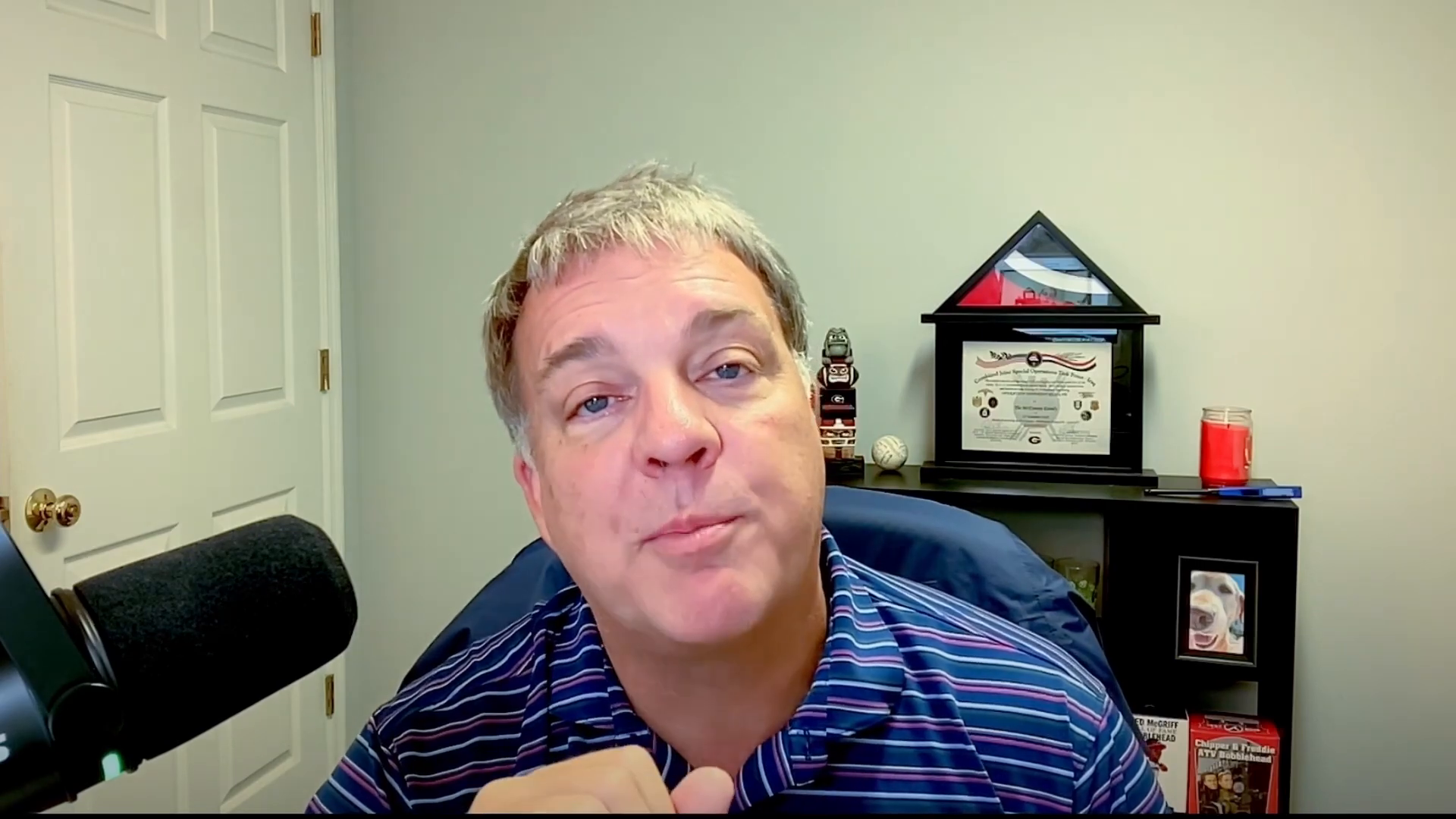
Long-Term Goals: Building an Asset
One of the most compelling arguments for private labeling is the potential to build a valuable brand asset. Successful private label brands can be sold for significant multiples, providing a lucrative exit strategy for entrepreneurs. This potential for long-term growth and brand equity is often a key motivator for those choosing the private label route.
While wholesale reselling can be profitable, it may not offer the same long-term asset-building potential. Resellers are often seen as intermediaries without the same level of brand recognition or customer loyalty. This distinction is essential for sellers considering their long-term goals and exit strategies.

Finding Your Path: Which Model is Right for You?
Ultimately, the choice between private labeling and wholesale reselling comes down to individual circumstances, goals, and preferences. For those with limited capital and a desire for quick returns, wholesale reselling may be the ideal starting point. It offers a lower barrier to entry and the ability to generate income relatively quickly.
Conversely, if you have the capital, creativity, and a long-term vision, private labeling presents opportunities for brand building and significant financial rewards. It requires more effort and investment upfront but can lead to a more sustainable and profitable business in the long run.

Conclusion: Making the Best Decision for Your Business
In conclusion, both private labeling and wholesale reselling have their unique advantages and challenges. Understanding these factors can help you make an informed decision that aligns with your business goals. Whether you choose to create a private label brand or pursue wholesale reselling, the key is to remain adaptable and continuously learn from your experiences in the ever-evolving e-commerce landscape.
For further insights and resources on excelling in e-commerce, consider subscribing to newsletters and following industry experts. Engaging with communities and learning from others can provide valuable guidance as you navigate your entrepreneurial journey.
Remember, the path you choose should reflect your strengths, resources, and aspirations. Both models can lead to success if approached with the right mindset and strategies.
For more information on optimizing your e-commerce business, check out eCom Catalyst and explore the resources available to support your journey.
The post Private Label vs Wholesale Reselling: Which Amazon FBA Business Model is BEST? first appeared on eComCatalyst - Amazon, e-Commerce Growth Agency.
12 August 2024, 9:22 pm - 3 minutes 44 secondsComfortably Numb – Episode #31Reading Time: < 1 minute
Who doesn’t love a good Pink Floyd song with perhaps one of the great guitar solos ever, right?
Hello? (Hello, hello, hello)
Is there anybody in there?
Just nod if you can hear me
Is there anyone home?This episode serves one purpose. It’s a super quick hello from Fred McKinnon to make sure that all of the fans of the former E-BusinessOnline Podcast know that we’re back.
I did this podcast many years ago, back in 2018 … and then stopped. This podcast/show has been completely inactive for A WHILE!
Then, we rebranded to eComCatalyst and started producing regular content on our YouTube Channel and I thought to myself “why not repurpose the audio from YouTube into a podcast”?
Rather than start a brand new show, we rebranded this VERY OLD, OUTDATED podcast feed and much to our surprise, we are seeing hundreds of downloads.
It seems that people stayed subscribed to the show, even though we didn’t post for years.
Are these stats real? Are there really HUNDREDS of people still getting this, and all of a sudden, waking up and seeing NEW CONTENT?
I wanna know … is anybody in there? Is anybody home? Can you hear me now?
If so, take a quick second and zip me an email. Let me know who you are and where you are listening from, and any other fun facts you want to share.
Hope to hear from you soon!
FredThe post Comfortably Numb – Episode #31 first appeared on eComCatalyst - Amazon, e-Commerce Growth Agency.
7 August 2024, 10:17 pm - 7 minutes 26 secondsCritical Deadlines for Amazon FBA Sellers During the Peak Q4 Holiday Season [Episode 30]
Reading Time: 3 minutes
As Q4 and the holiday season approaches, it’s crucial for Amazon FBA sellers to be aware of the key deadlines and strategies to maximize their sales potential. With Black Friday, Cyber Monday, and the Christmas selling season just around the corner, preparation is essential. This article will outline the important timelines, best practices, and tools available to ensure your products are ready for the peak shopping period.
Understanding Amazon’s Deadlines for Inventory Submission
Amazon has set specific deadlines for sellers to submit their inventory to FBA warehouses. Knowing these dates is vital for ensuring your products are available for customers during the busiest shopping days of the year. For 2024, the key deadline for inventory submission is October 19.
- October 19: Deadline for inventory to arrive at Amazon for “guaranteed” Prime availability for Black Friday.
- November 11 – December 29: Focus on processing orders, instead of receiving inbound shipments to FBA.
These dates are critical for ensuring that your products are Prime eligible and ready for Black Friday sales. Delay in submission can lead to missed opportunities and lost sales.
Importance of Early Planning
While it may seem early to think about the holidays in July, early planning is essential. Amazon’s fulfillment centers become increasingly congested as the holiday season approaches, making it more challenging to get inventory checked in and available for sale.
Amazon has indicated that during November and December, their primary focus will be on fulfilling customer orders rather than receiving new inventory. This shift emphasizes the need for sellers to have their products in place well ahead of the peak season.
Key Planning Steps for Sellers
To effectively prepare for the holiday rush, sellers should consider the following steps:
- Assess current inventory levels.
- Identify best-selling products for the holiday season.
- Plan your sourcing strategy well in advance.
- Utilize Amazon’s tools for inventory management.
- Monitor capacity limits and adjust shipments accordingly.
Utilizing the FBA Peak Readiness Playbook
Amazon provides sellers with a resource called the FBA Peak Readiness Playbook. This guide outlines best practices and strategies for managing inventory during the peak season. It’s an invaluable tool for sellers looking to optimize their operations.
Key components of the playbook include:
- Inventory management tips
- Deadlines for sourcing deals
- Guidelines for using the FBA Capacity Monitor
By leveraging this resource, sellers can better position themselves for success during the holiday season.
Understanding the FBA Capacity Monitor
The FBA Capacity Monitor is a crucial tool for sellers to understand how much inventory they can send to Amazon’s fulfillment centers. It helps in planning and managing your stock levels, ensuring that you do not exceed capacity limits.
Here’s how to effectively use the FBA Capacity Monitor:
- Check limits regularly for updates.
- Adjust your shipments based on capacity availability.
- Plan for overages and avoid additional charges.
Strategies for Successful Holiday Sales
Beyond meeting the deadlines, there are several strategies that sellers can adopt to maximize their sales during the holiday season. Here are some effective tactics:
Effective Marketing Strategies
Marketing is essential to attract customers during the holiday rush. Here are some strategies to consider:
- Utilize Amazon Advertising for promotions.
- Create compelling product listings with high-quality images.
- Offer discounts and deals to entice buyers.
- Leverage social media to drive traffic to your listings.
Optimize Your Listings
Ensure that your product listings are optimized for search visibility. This includes:
- Using relevant keywords in titles and descriptions.
- Regularly updating your inventory and pricing.
- Encouraging customer reviews to build trust.
Conclusion: Take Action Now!
As the holiday season approaches, it’s imperative for Amazon FBA sellers to take proactive steps to ensure their products are ready for sale. From understanding deadlines to utilizing Amazon’s tools, thorough preparation can lead to a successful selling season.
Don’t wait until the last minute. Start planning your inventory now, and take advantage of all resources available to maximize your sales potential. Remember, the key to success lies in early preparation and strategic planning.
If you found this information helpful, consider subscribing to our channel for more insights or book a consultation with us. With over 20 years of experience in e-commerce and a proven track record of success, we’re here to help you navigate the complexities of selling on Amazon and beyond.
The post Critical Deadlines for Amazon FBA Sellers During the Peak Q4 Holiday Season [Episode 30] first appeared on eComCatalyst - Amazon, e-Commerce Growth Agency.
31 July 2024, 1:49 pm - 7 minutes 26 secondsWelcome to eComCatalyst: Your Partner for E-commerce Success [Episode 29]Reading Time: 2 minutes
Hello, Fred McKinnon here! I’m excited to introduce eComCatalyst, formerly known as E-Business Online. We’ve rebranded to better reflect our mission and services in the e-commerce world. Let’s dive into who we are, what we do, and how we can help you.
About Me and eComCatalyst
I’m Fred McKinnon, the founder of eComCatalyst. My journey began over 20 years ago as an Amazon seller. Yes, I’ve been in the e-commerce business for more than two decades! With over $100 million in revenue through my accounts and our clients, I’ve seen and learned a lot.
My e-Commerce Journey
It all started with a $99 investment in a drop-ship directory. From there, I opened an Amazon zShop, which preceded Amazon Seller Central. I uploaded my first spreadsheet and began making sales. My business thrived, transitioning from drop-shipping to wholesale, FBA flips, and eventually private labeling. This journey taught me invaluable skills in sourcing, negotiating, and understanding logistics.
The Birth of eComCatalyst
With extensive knowledge, I began offering one-on-one consulting. This was the beginning of E-Business Online. As we grew, it became clear that we needed a name and brand that matched our vision. Enter eComCatalyst, a full-service e-commerce marketing agency.
Our mission is to be your TRUSTED E-Commerce PARTNERS to be the CATALYST for your BRAND’s Success!Services We Offer
At eComCatalyst, we provide a comprehensive range of services:
- Full-Service E-commerce Management: We act as an extension of your team, handling everything from listing creation and optimization to SEO, product research, and market analysis.
- Graphic Design: Our in-house team creates compelling images, infographics, A+ content, and beautiful storefronts for Amazon and other platforms.
- Logistics Management: We manage inventory replenishment for Amazon, Walmart, and other marketplaces.
- Compliance and Account Support: We have specialists with insider knowledge of Amazon Seller Support to handle any issues you face.
- PPC Management: Our team has been managing Amazon PPC since its inception, delivering top-notch campaigns.
We tailor our services to fit your needs, whether you require full management or specific support like PPC.
The eComCatalyst Difference
What sets us apart is our family-oriented approach. When you work with us, you get a partner who cares about your business as much as you do. We see our clients as family and are dedicated to building lasting relationships.
Free Resources
Not ready for full-service management? We offer plenty of free resources to help you:
- Newsletter: Sign up for our newsletter for tips and updates.
- Complimentary Consulting: Book a free 15-minute consulting session.
- YouTube Channel: Check out our YouTube videos for valuable insights on Amazon, Walmart, Etsy, TikTok Shop, and more.
Join the eComCatalyst Family
Thank you for considering eComCatalyst. We look forward to helping you achieve e-commerce success. Follow us on our journey and become part of our growing family.
To get in touch, email us at [email protected], visit our website, or connect through our social media channels. Don’t forget to subscribe to our YouTube channel and sign up for our newsletter for the latest tips and strategies.
Together, let’s make your e-commerce dreams a reality. Welcome to eComCatalyst!
The post Welcome to eComCatalyst: Your Partner for E-commerce Success [Episode 29] first appeared on eComCatalyst - Amazon, e-Commerce Growth Agency.
27 July 2024, 8:06 pm - 32 minutes 39 secondsAmazon’s New Social Media Codes, Wasted Ad Spend, and Long-Term Storage [Episode 28]Reading Time: 3 minutes
Hello EBO’ers:
Welcome back to the E-BusinessOnline Podcast – this is Episode 27 where we’re talking about Amazon Seller Fulfilled Prime and some of the pitfalls in purchasing liquidation lots for resale.
DON’T FORGET THE CONTEST TO WIN ONE HOUR OF FREE E-Commerce COACHING!
***CONGRATS TO JODI KLINE, our January 2018 WINNER of one hour of free consulting/coaching.***I want to kickstart our EBO Community so I’m hosting a fun little contest to offer a ONE HOUR FREE CONSULT with me for your e-Business. This can be by phone, Skype, or if you are within travel distance of Southeast Georgia or Northeast Florida and want to come to St. Simons Island, GA and hookup, I’ll buy you lunch and we’ll talk shop for over an hour. This is worth hundreds of dollars so you wanna win! You can earn as many as three entries into the contest by doing any of the following:
- Send me an email letting me know you’re listening to the show. (Put “Podcast” in the subject line!) I’d like to hear your thoughts, what you’d like to see in the show, questions, constructive criticism, etc. This gives you an entry.
- Leave a written review on the iTunes Podcast. (you will need to email or tag me with your review username when published)
- Share this podcast on Facebook. (You can share this post, or better yet, go to the page on iTunes and share it from there – see screenshot below). When sharing you will need to TAG the E-BusinessOnline Facebook Page so that I know you shared it. When you share the podcast to Facebook I won’t know (and give you another entry) unless you tag the Facebook Page, so don’t forget!
Today’s Show Topics:

- Amazon announces new “Social Media Coupon Codes” and gives sellers their own landing page to promote discounts. This can be a great way to easily get a landing page with your promotions to share on social media. One of the biggest advantages is that Amazon gives you settings to control the # of units a customer can buy and how often. It’s also an Amazon-built landing page so the customer is one click away from ordering your product. The biggest disadvantages is your loss of control on design and the ability to collect email addresses to build your list, as well as the inability to add your retargeting pixels (Facebook, Google, etc).
- How much wasted ad spend do you have? This is a question I was forced to address when my friend, Jon Kragh, owner of MySellerPal.Com, messaged me on Facebook to take a look at his new tool that shows this at-a-glance. I was shocked to find nearly $3,000 in wasted ad spend in the past 60 days. “Wasted Ad Spend” is those keywords that have clicks, costing you money, with no conversions (orders). Whether you use a tool like MySellerPal, Ignite, or just download the search term report in Excel – this is something everyone should check on. The surprising thing was that the wasted ad spend wasn’t a few expensive keywords, but was hundreds of cheap keywords that added up to thousands of dollars.
- February 15th is the date Amazon will charge Long Term Storage Fees (LTSF) on aged-inventory. Be sure to login to Seller Central and go to Reports > Fulfillment to find your aged inventory and possible LTSF so you can avoid these fees by removing inventory or discounting it to liquidate prior to the deadline.
I’d love to have EBOers report back on what they discovered in “wasted ad spend” – let’s see how much wasted ad spend we can report and more importantly, LET’S DO SOMETHING ABOUT IT!
The post Amazon’s New Social Media Codes, Wasted Ad Spend, and Long-Term Storage [Episode 28] first appeared on eComCatalyst - Amazon, e-Commerce Growth Agency.
9 February 2018, 3:55 pm - 49 minutes 3 secondsContest, Amazon’s Seller Fulfilled Prime, and Pitfalls with Liquidation Lots [Episode 27]
Reading Time: 4 minutes
Hello EBO’ers:
Welcome back to the E-BusinessOnline Podcast – this is Episode 27 where we’re talking about Amazon Seller Fulfilled Prime and some of the pitfalls in purchasing liquidation lots for resale.
DON’T FORGET THE CONTEST TO WIN ONE HOUR OF FREE E-Commerce COACHING!
I want to kickstart our EBO Community so I’m hosting a fun little contest to offer a ONE HOUR FREE CONSULT with me for your e-Business. This can be by phone, Skype, or if you are within travel distance of Southeast Georgia or Northeast Florida and want to come to St. Simons Island, GA and hookup, I’ll buy you lunch and we’ll talk shop for over an hour. This is worth hundreds of dollars so you wanna win! You can earn as many as three entries into the contest by doing any of the following:
- Send me an email letting me know you’re listening to the show. (Put “Podcast” in the subject line!) I’d like to hear your thoughts, what you’d like to see in the show, questions, constructive criticism, etc. This gives you an entry.
- Leave a written review on the iTunes Podcast. (you will need to email or tag me with your review username when published)
- Share this podcast on Facebook. (You can share this post, or better yet, go to the page on iTunes and share it from there – see screenshot below). When sharing you will need to TAG the E-BusinessOnline Facebook Page so that I know you shared it. When you share the podcast to Facebook I won’t know (and give you another entry) unless you tag the Facebook Page, so don’t forget!
AMAZON SELLER-FULFILLED PRIME:
Archie Clement from our EBO Facebook Community asks a great question about Amazon’s Seller-Fulfilled Prime program:
Would like to hear your thoughts on Amazon Seller Fulfilled Prime. We receive requests from Amazon from time to time to apply, but we don’t currently have the infrastructure in place to ship orders the same day they are received, and in addition we only have a single warehouse in Texas, so it would require air shipping to many locations to achieve 2 day delivery. Seems to me it could only work with product inventoried in regional fulfillment centers or something.
- Seller-Fulfilled Prime is a program that allows Sellers to ship their own items from their own warehouses and still get the “PRIME” badge on their listings, capturing those Amazon Prime shoppers.
- The biggest disadvantage to the program is that you have to purchase your shipping from Amazon and the rates are not very discounted.
- The advantage is that you don’t have to commit to Prime Shipping for the entire country, but can define it by region, and only offer to those customers that you can reach in 2 business days via cheaper, ground shipping.
PITFALLS WHEN BUYING LIQUIDATION LOTS:
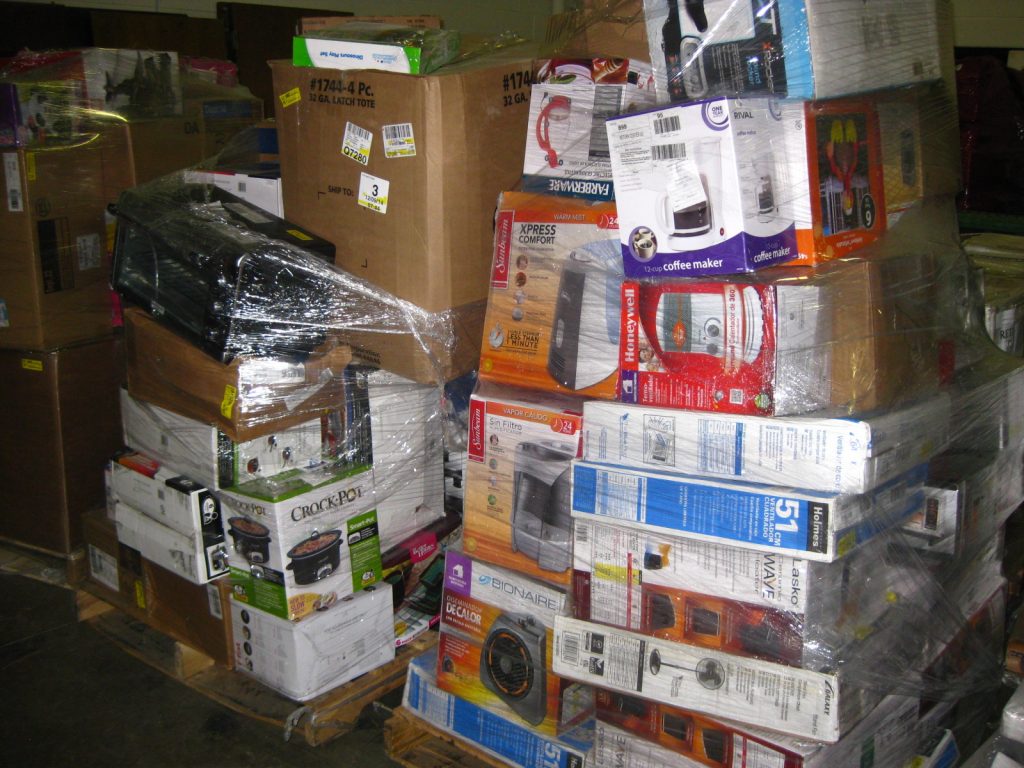 One of the hot trends that people are jumping on these days is purchasing inventory through liquidation sites. The hype is that you can get amazing deals for pennies on the dollar and sell them in new, open-box, or used condition for huge profits. Sometimes this is true and it can definitely be a great opportunity but as with anything, there are some downsides and pitfalls. Fred discusses a few pitfalls he’s experienced through is own mistakes and share them to save you a lot of time, money, and frustration.
One of the hot trends that people are jumping on these days is purchasing inventory through liquidation sites. The hype is that you can get amazing deals for pennies on the dollar and sell them in new, open-box, or used condition for huge profits. Sometimes this is true and it can definitely be a great opportunity but as with anything, there are some downsides and pitfalls. Fred discusses a few pitfalls he’s experienced through is own mistakes and share them to save you a lot of time, money, and frustration.- avoid consumer electronic returns – they need to be thoroughly tested before being resold. The same is with computer components. If you don’t have a quick easy way to test before reselling, stay away. We had a large % of electronic returns come back to us due to defects that could not be caught without extensive testing. In some cases, items are returned for no valid reason and they are a great buy; however, in most cases, the items were returned for a reason.
- avoid opened/returned video games. Customers install these on their consoles and register games, or steal upgrade codes making the returned game useless in many cases.
- Pay attention to the category of the products and what conditions are allowed. For example, we purchased a lot of returned Baby products and in most cases, Amazon would not allow us to list in “Used” condition in this category.
- Pay attention to product reviews – in MANY cases, a product is being liquidated for a GOOD REASON. For example, we got an amazing deal on a well-known fitness tracker but the customer reviews on Amazon for this particular model were TERRIBLE. The items we purchased were brand new, retail box, not refurbished or used — yet, the overwhelming majority of them were returned by customers who left bad feedback and we lost a lot of money. All the return reasons matched the very negative product reviews on Amazon. Don’t get swept away by the deal and the potential estimated sales. Junk is junk, and your time is valuable. Shipping to customers then paying for prepaid return labels and dealing with unhappy customers and negative feedback is a big hit to any potential profits you thought you would make.
- If it’s too good to be true, it usually is. BEWARE of counterfeit and inauthentic goods. Knock off items that appear to be OEM/Original are usually much lower quality and can also get you into suspension trouble with copyright/counterfeit claims. If you buy generic items, be sure to sell them as such. And if the listing seems to suggest that they are true “X” brand goods and the price is too good to be true, you are probably buying counterfeits.
- Pay attention to the manifests. Liquidation lots with dozens of individual items take a lot of time to process – especially if they are returned items. They require someone to physically examine and access the condition of the item. This can’t be done easily by an overseas VA since they don’t have the ability to touch and test the product. Also, some liquidation sites pad the auction titles with the highest value item(s) and the overall lot may only have a very limited number of high value items and the rest of the items are junk.
As mentioned in the podcast, these are pitfalls and avoiding them can save you time and money. However, there are definitely some great opportunities in this field as well. It’s a great way to diversify your income streams in your e-commerce business.
Some liquidation sites that I am familiar with:
The post Contest, Amazon’s Seller Fulfilled Prime, and Pitfalls with Liquidation Lots [Episode 27] first appeared on eComCatalyst - Amazon, e-Commerce Growth Agency.
30 January 2018, 2:28 pm - 29 minutes 33 secondsEBO New Year 2018 – Hype, Hysteria, and Honesty plus CONTEST! [Episode 26]
Reading Time: 2 minutes Hello EBO’ers: Welcome back to the E-BusinessOnline Podcast – the first episode in many months and our first for 2018. In this episode: CONTEST: I want to kickstart our EBO Community so I’m hosting a fun little contest to offer a ONE HOUR FREE CONSULT with me for your e-Business. This can be by phone, […]
The post EBO New Year 2018 – Hype, Hysteria, and Honesty plus CONTEST! [Episode 26] first appeared on eComCatalyst - Amazon, e-Commerce Growth Agency.
18 January 2018, 2:09 pm - More Episodes? Get the App
 The eStore Coaching Podcast - Build. Market. Grow. | The 3 Pillars of an Online Business
The eStore Coaching Podcast - Build. Market. Grow. | The 3 Pillars of an Online Business
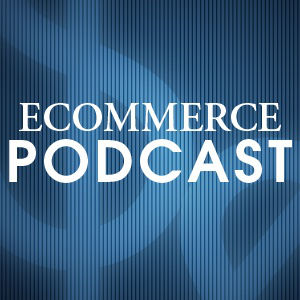 E-commerce Podcast : Hear from Ecommerce Experts and Learn How to Succeed in Online Retailing
E-commerce Podcast : Hear from Ecommerce Experts and Learn How to Succeed in Online Retailing
 Think Entrepreneurship | Interviews with Entrepreneurs | Entrepreneur Tips, Advice, and Inspiration
Think Entrepreneurship | Interviews with Entrepreneurs | Entrepreneur Tips, Advice, and Inspiration
 Ecommerce Conversations by Practical Ecommerce
Ecommerce Conversations by Practical Ecommerce
Your feedback is valuable to us. Should you encounter any bugs, glitches, lack of functionality or other problems, please email us on [email protected] or join Moon.FM Telegram Group where you can talk directly to the dev team who are happy to answer any queries.
